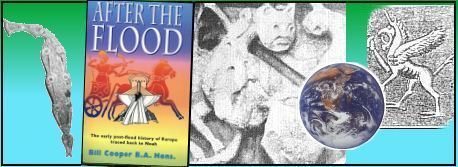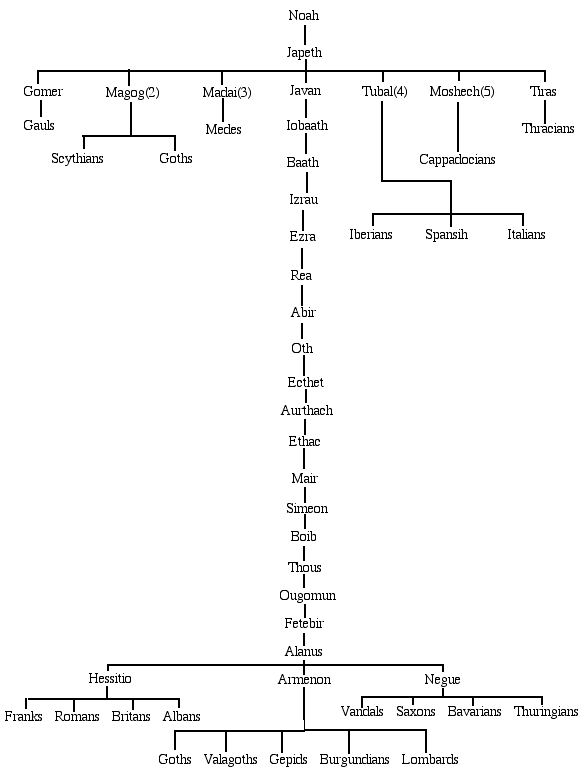
After the Flood - by Bill Cooper |
CHAPTER
I
CHAPTER II CHAPTER III CHAPTER IV CHAPTER V CHAPTER VI CHAPTER VII CHAPTER VIII CHAPTER IX CHAPTER X CHAPTER XI CHAPTER XII CHAPTER XIII |

After the Flood - by Bill Cooper |
CHAPTER
I
CHAPTER II CHAPTER III CHAPTER IV CHAPTER V CHAPTER VI CHAPTER VII CHAPTER VIII CHAPTER IX CHAPTER X CHAPTER XI CHAPTER XII CHAPTER XIII |
| << PREV |
Europe traced back to Noah" |
'I, Nennius, pupil of the holy Elvodug, (1) have undertaken to write down some extracts that the stupidity of the British cast out; for the scholars of the island of Britain had no skill ...I have therefore made a heap of all that I have found... ,' (2)
With these words, Nennius opens his great book, Historia Brittonum - the
History of the Britons. It would be difficult to overstate the immensity
of Nennius' achievement and his contribution to our understanding of ancient
history. And, were we not familiar with the fashions of today, it would
be equally difficult to account for the disparagement that his name has
suffered amongst modernist scholars in ungrateful return for his labours.
His achievement was the gathering together of all the extant records touching
on the origins of the Britons that he could find and which he then set
down into one booklet was a time of danger for the Britons as a nation
and for the records themselves, and were it not for his labours, the immensity
of which we can only guess at, records that were irreplaceable would have
been lost to us forever. Morris' translation of Nennius, which opens this
present chapter, implies that the British of the time were stupid in the
sense of being intellectually dull. But in this context, the word hebitudo
which Nennius used, suggesting something that has been made blunt or
dull and which Morris renders 'stupidity', would perhaps better be translated
as complacency or lethargy, the mood of the Britons that followed in the
wake of the massacre of the monks at Bangor. The profound cultural shock
of seeing their finest scholars and spiritual leaders massacred by supposedly
fellow Christians at the instigation of a Roman bishop no less, would have
left a very deep wound indeed, and it is this state of mind amongst the
Britons or Welsh that Nennius laments and which led to the neglect and
loss of many records and books. They 'had no skill' (nullam peritiam
habuerunt), because learning had practically ceased amongst them. Hence
Nennius' sudden and urgent gathering together of all that remained.
Nennius completed his work towards the very end of the 8th century AD and the sources that he gathered were many and varied. They included certain items of history that had been imparted to him by Irish scholars. Then come the 'Annals of the Romans', 'The Law; another explanation', and, lapsing into his native Welsh, he then tells us that a noble elder named Cuana had compiled a British genealogy from a certain Roman (i.e. Latin) chronicle. (3) He was happy to rely on oral history too, quite unashamedly describing one such item as being 'in the writing of the writer's mind'. (4) But one of the really important aspects of his contribution in all this, is that Nennius made no apparent attempt to edit his sources or even correct some of their obvious discrepancies. Had he done so, then it would have been difficult for us to assess the actual and original contents of the records consulted by Nennius, and distinguish these from what was Nennius' own, perhaps mistaken, ideas about them. Instead, Nennius merely copied down his sources and passed them on to us, historical warts and all, so that we could make of them what we would.
A few, but only a very few, of the records preserved by Nennius, are admittedly of doubtful quality and reliability. But amongst them is one of the most important documents from the ancient world that could have come into our possession. It is set down in chapters 17 and 18 of Historia Brittonum (for the Latin text of these chapters, with translation, see Appendix 5 of this book), and it records the descent of a considerable number of early European nations. It is laid out as a conventional genealogy in what follows.
It is instructive to compare Nennius' Table of European Nations (as I like to call it) with Appendix 3 of this book, the genealogy of the nations of Japheth as recorded in Genesis. Nennius' source and Genesis are in remarkable agreement with one another, yet Nennius adds details that are not included in Genesis, for the natural and obvious reason that the Genesis account is necessarily brief. Gomer (1), for example, is merely cited by Nennius as being the ancestor of the Gauls, Nennius omitting entirely the names of Gomer's three immediate descendants, Ashchenaz, Riphath and Togarmah that are included in Genesis. (Would he have omitted these if he were merely copying straight from Genesis itself?) He cites Magog (2) as the ancestor of both the Scythians and the Goths, and Madai (3) as the founder of the Medes. So far so good. But it is from this point that the document from which Nennius was working, shows one or two tell-tale signs of the (albeit remarkably little) distortion that it has suffered in transmission, whether oral or written.
For example, and as we shall note in Appendix 3, Tubal (4) was the father of a people known to the Assyrians as the Tabali, whose land, Tabal, (present-day Georgia in what used to be the USSR, whose modern capital Tblisi perpetuates the name of Tubal), lay adjacent to that of the biblical Togarmah, (Assyr. Tegarama). From Nennius, however, comes the added detail that from Tubal came the Iberian, the Spanish and the Italian races. And this receives at least partial support from Josephus, who wrote some seven hundred years before Nennius, that Tubal was the father of the Thobelites, known. as Iberians in his own day. (5) And as Josephus makes no mention of either the Spanish or Italian races, nor yet the: descent of the Goths from Magog, Nennius was clearly not copying from him.

Likewise, Nennius' source cites Meshech (5) as the father of the Cappadocians (see Appendix 1:10 and 2:18 - the Caphtorim), an error that also appears in Josephus. It is doubtful though that Josephus originated these errors, simply because he was himself working from much older sources. The confusion, however, was easily brought about, for the name of the Semitic people of Mash in Genesis, is alternately rendered Meshech in 1 Chronicles. Clearly the two, the Semitic people of Meshech and the Japhetic people of Meshech, were confused with one another even in classical times, and it was upon the records of the classical world that both Josephus and Nennius relied rather than upon any mere copying of the Genesis record.
Other examples of distortion (albeit still of a minor nature) are seen in that the Goths are shown to have been descended from both Magog (2), the biblical patriarch, and from Armenon, the son of Alanus. Armenon himself is stated to have had five sons, yet only four are named. (Five nations are later shown to have descended from him.) Similarly, Negue is stated to have three sons, yet four nations derive from him. The significance of all this is that Nennius could easily have edited out or corrected these points, thereby enhancing his own credibility, yet he chose to simply leave them as they are. And it is this that, almost paradoxically, enhances his standing as a trustworthy and reliable historian, and it further assures us that we are reading these exceedingly ancient documents exactly as Nennius read them.
From Alanus onwards appears a comprehensive table of the nations of Europe. One or two of these names were archaic even in Nennius' time and would long have fallen into disuse. They are all, however, familiar to any historian today whose studies have touched upon the history of Europe at about the time of the Roman Empire. For several centuries, it seems, Europe was a seething cauldron as nation vied with nation in a bewildering array of migration, invasion and displacement. Yet not one of the names in this list of nations is historically unattested, not even that of the unlikely-sounding Gepids.
However, there is one particular aspect of this table that should be drawn emphatically to the reader's attention, because it is a matter of immense significance, a matter moreover that seems to have entirely escaped the notice of modernist scholars. It is the appearance of just four names in the early section of the genealogy. But this is not the only occasion on which we meet with them. They appear also in the patriarchal genealogy of the early Irish-Celts, and their chronological significance is just as great as their ethnic significance.
The names in the British account are: Iobaath, Baath, Izrau and Ezra.
But notice their position in the genealogy. They occupy the four generations immediately following Javan, the son of Japheth. When we later come to consider the genealogy of the Irish-Celts, which has been constructed from entirely different sources, we shall see that these same names occupy similar places, except that there they are descended from Magog, not Javan, and Baath is depicted as the elder brother, and not the son, of Iobaath.
Their names take the early Irish forms of: Jobhath, Biath, Easru and Sru, recognizably the same names as given in the British table.
However, it is the chronological position of those particular names in these ancient genealogies that provides a striking confirmation of the Genesis account. In the book of Genesis, we see that the dispersal of the nations from Babel took place during the fifth generation after the Flood. And here we are presented with the names of four successive generations of patriarchs who were common to the recorded ancestry of both the British and Irish Celts. (6) After the fifth generation, the lines of the British and Irish Celts diversify, exactly in accordance with the historical movement of the nations as depicted in Genesis. All of which is a strange occurrence in documents that are not only drawn from entirely independent ancient sources, but which the modernist school, if they cared to mention them at all, would have us believe are fictitious.
Nennius tells us that he found the above record in 'the ancient books of our elders' (Aliud experimentum inuern ... ex ueteri bus libris ueterum nostrorum), and we need now to establish when this ancient document was written. It is crucial to establish this, because leaving the question open would allow the familiar and by now wearisome charge to be made that it was forged by Christian monks as an act of 'pious fraud'. To settle the matter we will now examine the work of Geoffrey of Monmouth who, like Nennius, was a Welsh monk and who lived some three hundred years after him. The importance of Geoffrey's work lies in the fact that he carried the story forward from where Nennius left off, and it is the abundance of internal and external evidence from Geoffrey's book that will enable us to assess the age, and thus the authenticity, of Nennius' earlier material.
| << PREV |
|
|